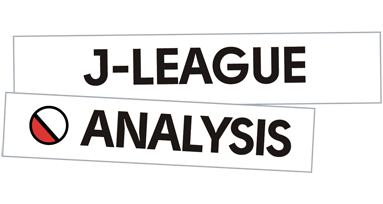It was derby day in the J-League on Tuesday, as Cerezo Osaka played host to their cross-town rivals, Gamba Osaka at the Yanmar stadium. With a handful of points separating both sides on the table, a win today would be crucial in trying to break away from the mid-table pack. History has also shown us that this matchup has been a close affair with Gamba winning three out of the five previous meetings. However, out of those five, Cerezo have won the last two times that these sides have come together.
This tactical analysis will dissect the tactics used by both sides, showing how each team created their opportunities on goal. This analysis will also look at the key moments of the game which were crucial for generating attacking momentum for both Cerezo and Gamba.
Lineups
Lining up in their 4-4-2 formation, Cerezo Osaka kicked off with Jun Hyeon Kim as their starting goalkeeper. The back four consisted of centre-back pairing Tasuki Kimoto and Matej Jonjić, whilst Tasuka Maruhashi and Riku Matsuda held the width as right and left fullbacks. In the heart of midfield, Naoyuki Fujita and Leandro Desábato looked to link play between the front and backline whilst making sure the team remained defensively balanced in transitional moments. Hiroshi Kiyotake and Tatsuhiro Sakamoto were positioned as the left and right midfielders. Finally, the strike pair of Yuta Toyokawa and Hiroaki Okuno made up the front line of Cerezo’s attack.
Mirroring their cross-town rivals, Gamba Osaka also lined up in a 4-4-2 formation. Masaaki Higashiguchi started between the sticks whilst Yuya Fukuda, Young Gwon Kim, Shunya Suganuma, and Ryu Takao made up the back four. From left to right forming the midfield line of four were Shu Kurata, Yuki Yamamoto, Yosuke Ideguchi and Kosuke Onose. That left the Gamba Osaka youth team product, Takashi Usami, and Brazilian centre forward, Patric, as the pair up front. Whilst having started in the Gamba Osaka youth system, Usami had a loan spell at Bundesliga giants, Bayern Munich, in 2011 before moving to Hoffenheim the following season.
Destabilising Gamba’s block
When Gamba recognised that they could not place any direct pressure on the Cerezo’s ball carrier, they dropped off and formed their mid/low block of a 4-4-2. As Cerezo shifted the ball across, Gamba were happy to slide with them and prevent passes from finding the strikers and tucked in wingers. Somehow, in order to find the strike pair of Okuno and Toyokawa in the box, Cerezo had to pull apart their opposition’s defensive block. What they realised was that in wide areas, the opposition’s winger would end up tracking the fullback if he continued his run down the touchline. This would take a player out of the midfield line and create a backline of five players.
As a result, this left Gamba weaker far side on the switch of play. Whilst the overload to isolate principle can be effective, the speed of ball circulation needs to be quick so that the defensive block doesn’t have time to shift across. However, for Cerezo, the aim of the switch of play was not to get the far side player in isolation so that he could cross or drive. The intention was to disconnect the opposition’s centre back and fullback so that they could release one of their midfielders in the space behind.
Above we can see that Maruhashi (positioned as the fullback) is pushing forward as the centre-back is driving into the midfield line. As a result, Onose (as Gamba’s right-winger) follows him creating the backline of five. Through Okuno dropping deeper and bouncing Fujita, Cerezo are then able to switch play to the far side.
In order to prevent the pass to Desábato, Gamba’s left-winger Kurata has to stay central and mark Matsuda. Now because of the limited numbers in midfield, Gamba’s left fullback shifts early to engage Sakamoto and prevent him from progressing. Now the issue comes from the left centre back, Kim, not wanting to slide all the way across and get caught out of position. As a result, the large space is then created for the Argentinian midfielder to attack and the defensive block is out of shape.
Again we see a similar situation minutes later where Murahashi’s positioning on the left has caused the right-winger to drop and form a backline of five. The switch of play is then made and as such, the fullback anticipates the ball going wide and marks Okuna before Matsuda has even received the ball.
This then opens up the passing lane for Sakamoto to attack the space between fullback and centre-back. To prevent this pass from happening, Gamba’s manager Tsuneyasu Miyamoto could tell the left winger to sit back and protect that space. As in the picture above, since he goes and presses Matsuda, he then leaves that space unprotected and allows the pass. Once they have our defensive block reorganised with both lines of four, then he can place pressure on the ball carrier in the midfield line.
Gamba in transition
A significant portion of Gamba’s attacking opportunities came through transitional moments where they looked to find the highest players early as possible. This was so they didn’t give Cerezo time to get their defensive structure set early. Out of the 101 times that Cerezo lost the ball, 43 of those losses came from the attacking third. This means that Gamba built their attacks from deeper positions. But as previously mentioned, if they could win the ball back and find the highest player early, then they could bypass one (potentially two) lines of defence. In the situations where they weren’t able to find a long pass due to the pressure on the ball carrier, the ball would be recycled and shifted to someone who could find that pass or progress forward.
Because of the size and strength that Patric possesses as a striker, he became the target man for those aerial balls. This was also a clear tactic higher up the field where the Gamba’s wide players looked to cross in early into the box to find the Brazilian striker. Throughout the whole game, Patric had 20 aerial duels (the most of any player throughout the game) and was successful in finding a teammate 50% of the time.
Despite being strong in aerial duels, this phase of play only worked if he had supporting teammates to receive the ball. It is difficult for a striker to keep possession of the ball if he has two centre-backs on him and no supporting teammates. However, Gamba managed this situation well as exampled below.
In this situation, Onose had received the ball after his teammates won possession back around the box. He then makes the long aerial pass to Patric who is starting to drop to shake off his marker. Whilst Gamba are numerically disadvantaged in this situation there are two things to like about this picture. The first is that as the pass is being played to the Brazilian, a supporting midfielder is rushing up to receive the pass or second ball. Secondly, at the same time, Usami is starting his run to attack the space in behind. Therefore, Gamba now have support and attacking options.
The variation to this situation is that when the long ball is being played to Patric, if there are no supporting midfielders then Usami would be the one to position himself underneath. If there are no supporting midfielders but Patric has created space away from his marker, then Usami can still make his run in behind in anticipation for the flick-on header.
As seen above, throughout the game Gamba had good awareness and management of this situation. Similar scenario to the previous, however, Patric has drifted out wide and is able to link up with the closest supporting midfielder. Rather than keep forward momentum and attack Cerezo’s backline through Usami, Cerezo opt to recycle the ball back to the defenders and keep possession. Therefore, although there is a risk-reward element to long balls in transition, Gamba were able to manage these scenarios choosing when to attack and when to recycle.
Cerezo playing out
Throughout the game, Gamba pressed in a similar fashion. Both strikers were responsible for the centre backs, midfielders on midfielders and wingers on fullbacks. Whilst they pressed aggressively to start, Cerezo were able to find different ways to bypass their defensive lines.
Initially, because Gamba used their strikers to cover both the centre-backs and wingers, this meant that most teammates ball side were marked up. Therefore, the only option to progress was to play the long ball over the top and attack the space behind.
However, this was not the style of football Cerezo intended on maintaining throughout the game so, in the same situation, the fullbacks would look to play back to the centre backs early.
After a period of possession where they were able to move the ball around the back, Gamba then decided to press higher and place tighter pressure on the midfielders and back four looking to progress the ball forwards. Because the two lines of defence had stepped forwards, this left a large gap in between the midfield and defensive line. Both centre backs Jonjić and Kimoto were aware of this gap and were able to find Sakamoto and Kiyotake out wide off a longer aerial pass. As both players received the ball in that large space, they were then able to link up with the closest supporting midfielders.
One of the solutions that Cerezo had come up with was to use rotations to open up spaces in wider areas for players to receive the ball. The first rotation was using one of the holding midfielders to push out wide and create a 3 v 2 with the pressing striker and winger. The second rotation was to open up the space between Gamba’s midfield and defence so that one of the strikers could appear into and receive the ball.
Above, Matsuda is on the ball and is immediately pressed by Gamba’s left-winger, Kurata. Cerezo’s ball side holding midfielder has fixed his direct marker and opened up the gap between the two lines of defence. Intelligently, Toyokawa makes two movements. One to receive the ball and suck in the defender, and the other to attack the space in behind to drag away his marker. As Toyokawa makes the second movement, Okuno is then able to drop and receive the ball in free space and link up with the supporting midfielder.
By the way Cerezo played out from the back, it served as a reminder that good teams have back up plans for when they notice a change in their opponent’s pressing style. As a number of well-known coaches have stated previously, “it is like solving a puzzle”.
Conclusion
This tactical analysis highlighted the different tactics used by both teams in the Osaka derby. With both teams using different methods to create goal-scoring opportunities, the game finished with a 1 – 1 draw. As it stands, Gamba Osaka now sits in second place with 52 points, only three points away from third and fourth placers Nagoya Grampus and Cerezo Osaka.















